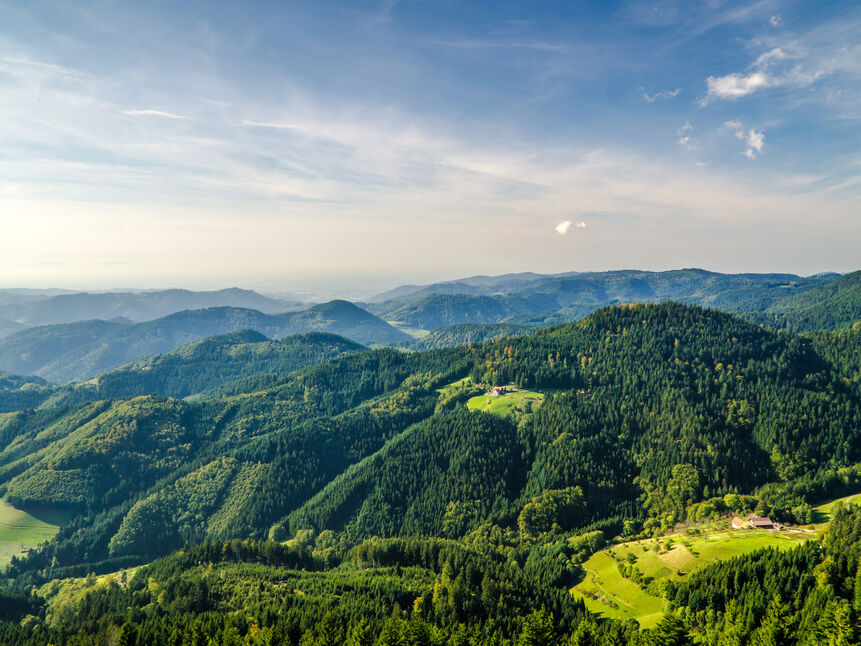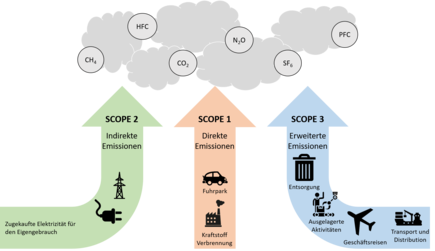Frequently asked questions
Here you will find frequently asked questions and answers on the topics of climate change, carbon footprints and climate protection.

Here you will find frequently asked questions and answers on the topics of climate change, carbon footprints and climate protection.
The climate impact of the individual greenhouse gases varies, for example 1 kilogram of methane corresponds to the climate impact of 23 kilograms of CO2 and 1 kilogram of sulphur hexafluoride (SF₆) corresponds to 22,800 kilograms of CO₂.
Basically, a total of six climate-relevant greenhouse gases are recorded and converted into the CO₂ equivalent (CO₂e) “common currency”. There is a conversion factor for each greenhouse gas. However, such so-called emission factors also exist for energy consumption, transport, travel, paper, waste, food, etc. After data collection, all influencing variables are converted into CO₂ equivalents, thus resulting in the CO₂e footprint.
The methodology is described in detail in international standards such as the Greenhouse Gas Protocol of the World Resource Institute and World Business Council for Sustainable Development or relevant ISO standards.

Scope 1 includes all greenhouse gas emissions that occur directly in the company, through combustion in its own facilities. This includes, for example, emissions from boilers or the company’s own vehicle fleet. Greenhouse gas emissions from
Scope 2 includes all indirect greenhouse gas emissions resulting from the provision of energy to the company, i.e. all greenhouse gas emissions resulting from the provision of electricity, natural gas, district heating or district cooling by an energy supply company.
Scope 3 includes all other greenhouse gas emissions associated with the company’s activities. These include greenhouse gas emissions from outsourced business units, greenhouse gas emissions from waste disposal and recycling, greenhouse gas emissions from business travel or employee commutes, etc.
This can be done through energy efficiency, switching to renewable energies and filtering greenhouse gases from power plants and production facilities, but also through reforestation or appropriate measures in agriculture.
Investments in developing and emerging countries are usually more efficient, as the effect per Euro invested is stronger due to differences in purchasing power. In addition, high-quality climate protection projects also have numerous additional benefits such as jobs, educational facilities, health facilities, quality of life improvements, etc. This can improve the situation of people in developing countries in general and, in the best case scenario, counteract possible migration.
There is a “mandatory market” and a “voluntary market”.
In the “mandatory market”, the states allocate a fixed quantity of emission certificates per year to all companies obliged to trade in emissions. This amount is less than the amount of emissions caused by these companies. The remaining emissions reductions must be achieved by these companies through savings measures or by buying emission certificates from companies that do not need them because they have taken savings measures on a larger scale. The intention is to create incentives for measures to reduce emissions through a high market price for tradable emission certificates.
The “voluntary market” enables emissions offsets away from government regulations for responsible companies, organisations and individuals.
One tonne of CO₂e can be offset much more cheaply with a huge reforestation project in the Amazon rainforest in Brazil than through a small recycling and awareness-raising project in Romania.
On average, an Austrian emits 10 tonnes of CO₂e per year, which is far from an acceptable level. In order not to further fuel climate change, only 2.0 tonnes of CO2 should be emitted per person per year.
Housing, water heating and public consumption cause about 2 tonnes of CO₂e per citizen per year – this is not considered to be something individuals can directly influence. However, with a total of around 8 tonnes of CO₂e, the majority of average greenhouse gas emissions are attributable to private consumption, heating, food, car and air travel as well as household appliances. Behind this are the greenhouse gas emissions that result from the use of materials and energy in the respective value chains of the product categories. The influence of the individual on this share of personal greenhouse gas emissions is considerable: While a “wasteful lifestyle” accounts for 14.5 tonnes of CO₂e, an “efficient lifestyle” produces only 5 tonnes of CO₂e. This illustrates the enormous influence that a private individual has through his or her decision-making power regarding consumption and lifestyle.
In addition, the company can actively work to make its employees, customers and other stakeholders aware of the importance of climate change and set a good example.
Climate protection is also strongly influenced by the behaviour of the people in a region. Climate protection is therefore promoted through the targeted creation of awareness among citizens for the implementation of climate protection measures.
Climate change describes the phenomenon that the average temperature of the Earth’s surface has risen by an average of about 1°C between 1900 and 2020. The future temperature increase on Earth is projected to range between 1°C and 6.5°C, depending on the scenario, with the upper end of this range being very likely. Taking into account the increase in CO₂ concentration that has already occurred, a minimum global temperature increase of about 4°C is expected by 2100 – unless we change our behaviour. Because every individual can have a positive impact on climate change.
In our region, for example, an extension of the growing season can be observed, causing plants to sprout earlier in spring. In addition, extreme weather events such as storms, hail or heavy rain and floods have increased noticeably in recent years.
• Health risks due to rising air temperatures and heat waves
• Weather extremes such as floods, storms and dry periods, forest fires
• Economic consequences for the elimination of consequential climate damage (the financial extent is difficult to predict – in some cases up to 15 per cent of annual global economic output has been assumed)
• Increase in hunger and water crises, especially in less developed countries
Emission savings are primarily achieved through more climate-friendly technologies. Carbon storage can be achieved through reforestation and agricultural measures that permanently increase the carbon bound in the soil.
Decision-makers in companies can ensure that climate-neutral or climate-friendly goods and services and renewable energy are purchased and that their own processes are designed to be as material- and energy-efficient as possible. The CO₂e footprint offers transparency and serves as a key figure that must be continually optimised. Currently non-avoidable greenhouse gas emissions can be offset by supporting high-quality climate protection projects.
Global warming is caused by the increase in the concentration of so-called greenhouse gases in the atmosphere, resulting in particular from the burning of fossil fuels (coal, gas and oil). This increases the so-called greenhouse effect: The short-wave radiation coming from the sun reaches the earth through the atmosphere, but the greenhouse gases only partially let the earth’s long-wave infrared radiation back into space. Another part is reflected and sent back to earth. This is one of the causes of the increase in temperature on Earth. The destruction of forests and intensive agriculture also play an aggravating role.
A second major cause is that, with the melting of the glaciers and ice surfaces, less heat radiation is reflected from the earth. Dark ground surfaces absorb much more heat than light or snow-covered surfaces. You are familiar with this effect: In the sun, light-coloured clothes heat up less than dark ones.
Feedback effects also play a role. For example, methane is trapped in permafrost soils and is released when these soils thaw. Another feedback effect is the increased amount of water vapour in the atmosphere, which is due to global warming. Water vapour is the most important greenhouse gas worldwide, contributing 60% to the greenhouse effect.